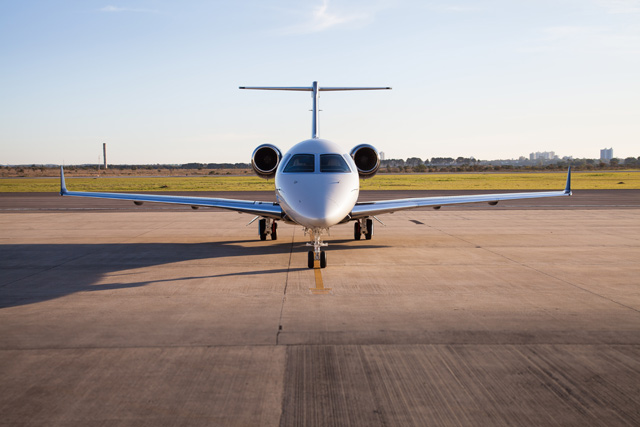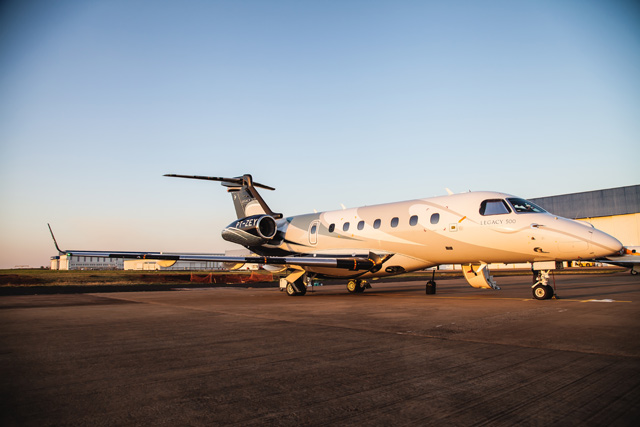Throughout my aviation career I have had experience flying with head-up displays, or HUDs: from the fairly rudimentary one in the General Dynamics F-111, used primarily for weapons aiming, to the large field of view (FoV) one in the Boeing C-17. The HGS system installed on the Boeing 737s I fly as an airline pilot allow Cat IIIa approaches, increasing schedule reliability. On preview flights in transport and business aircraft, the HUDs in the Boeing 787 and large-cabin Gulfstreams come to mind. Most would agree that a HUD can be a great safety enhancer, allowing flight of the aircraft with one’s head out of the cockpit.
As a pilot I find the safety benefit alone warrants the installation of a HUD. Aviation, however, is an expensive endeavour – so in reality many systems have to buy their way on to an aircraft. Where the addition of a HUD can be a real game changer is when it is combined with an enhanced vision system (EVS) to form an EFVS, or enhanced flight vision system. Some readers may ask, why the differentiation between an EVS and EFVS? The output of an EVS can be displayed both on a HUD and a panel-mounted display, but the EVS output needs to be on the HUD to be an EFVS. That is, the EFVS enhances the view by adding or highlighting features that may not be perfectly visible; electronic sensors can often “see” more than the human eye.
Current US Federal Aviation Administration rules allow the use of an EFVS to descend from the decision altitude/height (DA/DH) or minimum descent altitude (MDA) to 100ft above the touchdown zone elevation, if required visual references are visible on the EFVS. Descent below 100ft requires these same references to be visible using natural vision alone. This capability can be particularly useful to get into smaller destinations which aren’t serviced by precision approaches. A further capability enhancement is outlined in Draft AC 20-167A. This proposed rule change would allow descent below 100ft above the touchdown zone elevation if the required visual references can be observed using the EFVS. The deletion of the requirement to transition to visual references at 100ft may yield safety benefits equivalent to Cat II and III operations at many smaller airports with limited navigational aids.
HGS-3500 + EVS-3000 = E2VS
In an effort to increase flight safety and dispatch capability in poor weather conditions, Embraer is developing an EFVS for its Legacy 450/500 business jets. The E2VS (Embraer Enhanced Vision System) is comprised of a Rockwell Collins HUD, the HGS-3500, and an externally mounted three camera EVS, the Rockwell Collins EVS-3000.

Rockwell Collins three-camera IR and visual EVS-3000 unit
Embraer
All of the HUDs I have flown have been the projector type, with the projector either mounted overhead or below the display under the glareshield. One of the challenges of fielding an EFVS for a mid-size business jet is limited space in the cockpit. Collins’ HGS-3500 is a compact system that combines the projector and combiner (display) into a single overhead unit, called the pilot display unit (PDU). The compact size of the combiner yields a FoV of 30ºx21º (HxV), slightly smaller than the 32ºx26º in the HGS-4000 I fly on a regular basis.
Limited fore and aft space necessitated that the HGS-3500 be installed closer to the pilot than typical in a larger cockpit placements. The eye relief – the distance from design eye to combiner – for the HGS-35000 is only 6in, markedly less than the 9.5in of eye relief in HUD installation on Embraer’s E-Jets. Every other HUD I have flown has been either fixed or has a combiner that flips up towards the pilot to stow up against the headliner of the cockpit. The HGS-3500 has a unique stow action that allows the combiner to be parked directly over the pilot’s head when not in use. One benefit of the HUD’s compact size is, according to Embraer, that it weighs about 18kg less than a typical HUD.
The second major component of the E2VS is the EVS-3000. Single-camera systems in use today can be sub-optimal, particularly when there are differing energy levels from spectrum segments. Turning down system gain for bright approach lights, for instance, may dim terrain imagery too much. The EVS-3000 is a three-camera system housed in a single line-replaceable unit. A long-wave IR camera captures terrain and runway thermal signature. A short-wave infrared camera is optimised to view incandescent and halogen light sources. The third is a visual spectrum camera, installed to pick up LED lights. LED lighting seems to be the future for airport lighting, and this feature will be more than a nice-to-have. The IR sensors are uncooled, which should offer increased reliability and decreased maintenance costs.
NIGHT FLIGHT
The E2VS is nearing certification; I flew a development unit installed in a Legacy 500, registration PT-ZEY. It was the second 500 produced and has been retained by Embraer for projects such as this. On a dark September night I was offered a flight in PT-ZEY out of Embraer’s facility at Sao Jose dos Campos (SBSJ) to evaluate the E2VS. Accompanying me was chief legacy test pilot Eduardo Camelier. Once settled into the left seat, I used the pillar-mounted alignment balls to sit at the aircraft’s design eye position. Camelier guided me as I unstowed and rotated the HUD into position. Initially I found the combiner was a bit close to my face, the system’s eye relief being closer than other HUDs I had used. As the flight progressed, however, the combiner’s proximity became less noticeable. Primary HUD controls were two knobs located on the right side of the overhead mounted PDU. One knob, labelled HUD, controlled HUD symbology intensity; while the other, labelled Image, was an integrated brightness/contrast controller for EVS video. Other HUD controls were accessed via an FMS menu. These were: combiner mode (auto, declutter, full), image (off, SVS, EVS) and flight path vector cage (on, off).
Weather conditions were clear with the waxing crescent Moon illuminated 16% for our pre-flight activities. The Moon was setting as we taxied to SBSJ’s runway 33. Once cleared for takeoff, I selected TO/GA and advanced the thrust levers. The auto throttle engaged and set TO thrust. When Camelier called “rotate,” I pulled the aircraft symbol up to the 15º pitch ladder line. Once airborne I followed the HUD-presented flight display, which is a repeater of that in the primary flight display. We climbed to FL100 and transited southeast towards the coastal mountain range. At this altitude we were too high for any useful terrain video to be picked up by the EVS system. I could, however, make out some mid-level clouds, which were presented in the HUD. The SVS video stream can also be presented in the HUD, but I was focused on EVS capabilities and did not evaluate it.
During some gentle manoeuvres at FL100 I concentrated on the HUD display as a primary flight display. The symbology was as I was used to, with airspeed and altitude tapes. While the advertised FoV was only slightly smaller than I was used to, the area covered by the actual primary flight display symbology was too narrow. The resulting display was more of “portrait” layout and did not optimise the available display area. Overall I found it acceptable, but with room for improvement.

Flight-test evaluations of the enhanced vision system were conducted from the airframer's final assembly facility in São José dos Campos in Brazil
Embraer
Our return to SBSJ was via vectors to a hand-flown RNAV approach to runway 15. I was concerned about the lack of “hands on buttons” for HUD symbology control, but during the flight several features made it less of a concern. On each side-stick there is an EVS switch, used to toggle on-off EVS or SVS video. While in general I do not care for decluttered primary flight display modes, many pilots do. The 500 combiner has an auto position that declutters the display when the landing gear or flaps are extended while airborne.
The full primary flight display mode is regained when TO/GA is selected. High cross winds during approach can drive the flight path vector out of view. Like most HUDs, the HGS-3500’s flight path vector can be caged, but only by use of the above mentioned menu. The winds during our flight were light, but had there been a significant cross wind I would have liked the ability to cage the flight path vector in a more direct way.
EVS VIDEO
Once rolled out on final, I adjusted the EVS video using the PDU-mounted Image knob. The runway, surrounding terrain and structures were readily visible. Runway edge lighting was clearly displayed. The approach “rabbit” lights were also prominently shown, their proper sequencing also presented. HUD primary flight display symbology, the flight path vector and flight display circle in particular were easily discerned over the underlying EVS video. After executing a touch & go, the full stop landing was flown out of a visual circuit. For the last approach I used the HUD alone, finding the pitch ladders quite useful for establishing a 3º descent angle to the touchdown zone. After turning off the runway I stowed the HUD combiner for the taxi back to Embraer’s ramp.
SEGMENT-LEADING CAPABILITY
My brief introduction to the HUD and EVS system in the Legacy 500 showed it to be an extremely promising system. The HGS-3500 HUD performed well as a primary flight display and provided an acceptable palette for display of EVS video. Ambient conditions did not necessitate the use of the EVS but, based on the simulated instrument approach I flew, it may well be able to provide acceptable video for supplanting natural vision requirements on approach. The small footprint of the HGS-3500 enables it to fit in mid-size cockpits, while the entire E2VS’s low projected price of $515,000 makes it a relative bargain.
Read Mike Gerzanics’ report on flying the Legacy 450 atflightglobal.com//legacyflighttest
Source: FlightGlobal.com













